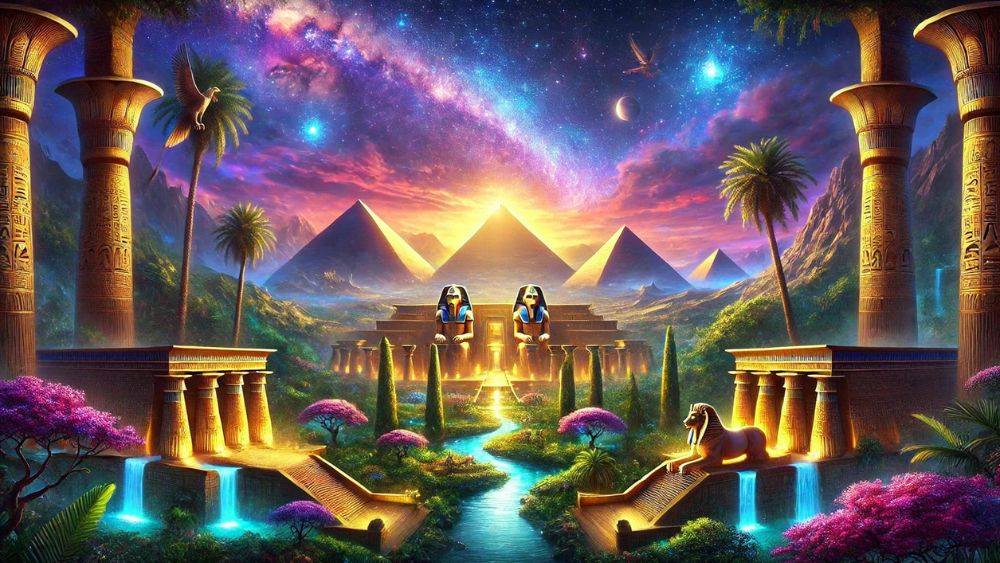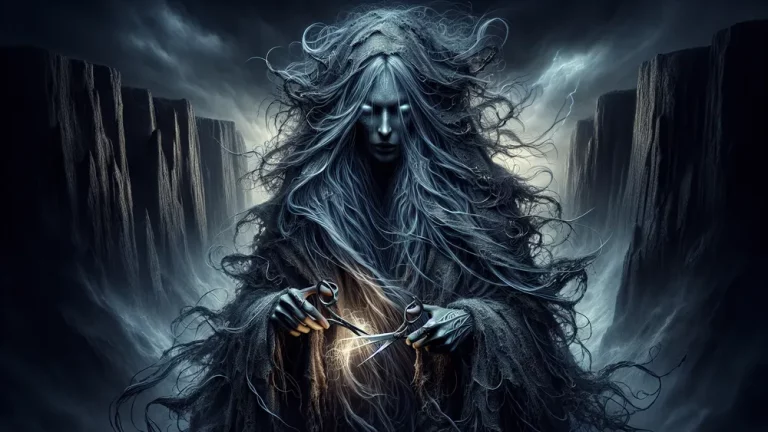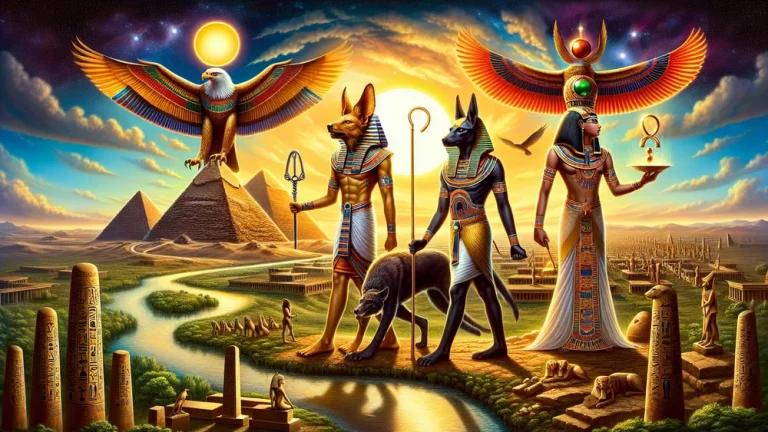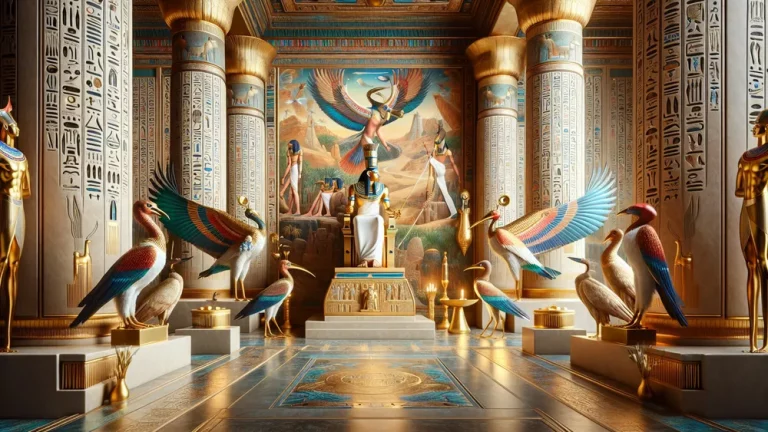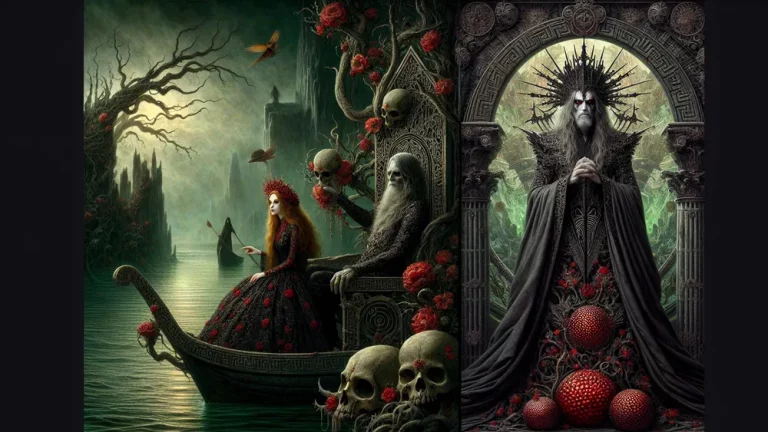Where Did The Egyptian Gods Live In Mythology?
Exploring Divine Realms in Egyptian Stories
In the stories from Egypt, gods lived in different places, each one with special features and meaning. Now, consider these divine places to know where people thought gods stayed.
Key Points:
- Egyptian gods lived in the sky, underworld, and specific earthly locations.
- Ra and Nut were sky gods, with Ra moving in a sun boat and Nut as the sky goddess.
- The Duat was the underworld ruled by Osiris, where souls faced tests and judgment.
- Temples were seen as earthly homes of gods, vital for worship and rituals.
- The Nile and stars held symbolic importance in Egyptian myths.
- Ra’s solar boat and Osiris’s resurrection were key stories in Egyptian mythology.
- Pilgrimages to sacred sites were crucial for connecting with gods.
| Key Point | Description |
|---|---|
| Sky Place | Many Egyptian gods, people thought, lived in the sky, often linked to sky things like the sun and stars. Gods like Ra, the sun god, and Nut, the sky goddess, are key examples. |
| The Duat (Land of the Dead) | The Duat, also called the underworld, was where Osiris ruled. It was a tough and dangerous trip for souls, with many tests and the weighing of the heart. |
| Land Homes | Some gods were believed to live in certain spots on Earth, usually marked by temples and holy places. For example, Amon-Ra was linked to Thebes, and Hathor to Dendera. |
| Temples as God Houses | Temples were seen as the earthly dwellings of the gods, where rituals and gifts were given to honor them. These buildings were very important both in design and spiritual practices to ancient Egyptian religion. |
| Symbolism of Nature | The sky, the stars, and the Nile held strong symbolic meanings in Egyptian stories. They were often viewed as signs of divine power and were critical to many myths and religious actions. |
The Sky Realm
In Egypt’s stories, the sky realm was seen as a big, divine space where many gods were thought to live. The sky and stars were very important, often looked at like the place where gods showed their stories. Think of the sky as a huge, high home, where gods like Ra and Nut had key roles.
Ra, the sun god, was believed to move across the sky in his sun boat, bringing light and life to the world every day. Nut, the sky goddess, was pictured as a large figure bending over the Earth, her body full of stars, showing the night sky. People in Egypt saw the sky as a place of order and balance, reflecting the divine harmony they believed ruled the universe.

- Ra: The sun god who moved across the sky in his sun boat, showing the cycle of day and night.
- Nut: The sky goddess who made the heavens, her body full of stars, showing the night sky.
- Horus: Often linked to the sky, especially the sun and moon, shown as a falcon flying above.
The sky in ancient Egypt represented a divine space where gods like Ra and Nut played essential roles, with Ra moving across it in his sun boat and Nut pictured as a sky goddess full of stars.
The Duat: The Underworld
The Duat, in Egyptian stories, was the underworld. It was a strange, dangerous place where the souls of the dead went on a journey after death. Think of the Duat as a big, dark maze with challenges and tests that the soul had to get through to reach the afterlife. This place was not just dark but also had rivers, caves, and gates guarded by scary gods and creatures.
So, the trip through the Duat was a test to see if the soul was pure and strong, aiming to reach the Field of Reeds, which was a perfect version of life on Earth. Osiris, who was the god of the afterlife, ruled the Duat and watched over the judgment of souls. He was often shown as a mummified king, which meant resurrection and living forever.
The importance of the Duat in Egyptian stories is very high. It was central to their beliefs about life after death and the eternal journey of the soul. Egyptians thought that the soul’s trip through the Duat was important to become immortal. This trip had the weighing of the heart ceremony.
Here, the heart of the dead was weighed against the feather of Ma’at, who was the goddess of truth and justice. If the heart was found pure and balanced, the soul got to pass to the afterlife. But, if not, it was eaten by Ammit, a scary creature that was part lion, hippopotamus, and crocodile.
Because of this belief, living a good life was very important, as the soul’s fate depended on it.
- Osiris: The god of the afterlife, who ruled the Duat and judged the souls of the dead.
- Anubis: The god of mummification and graves’ protector, who guided souls through the Duat.
- Ammit: The devourer of the dead, who ate the hearts of those not worthy in the afterlife.
Gods’ Homes on Earth
In old Egyptian stories, some gods were thought to live in certain places on Earth, making these spots holy and special. These earthly homes were marked by big temples and special sites, which showed the gods’ presence. Think of these temples as holy houses, similar to how now places of worship are viewed as homes of God.

The temple of Amon-Ra in Thebes was not just a place to worship but a home for the god, where rituals and gifts were given to honor him. Similarly, the temple of Hathor at Dendera was her home on Earth, where she was honored as the goddess of love, beauty, and music. These holy places were built carefully to show the divine nature of the gods they honored.
The buildings, design, and even the placement of these temples were picked to fit with religious beliefs and cosmic ideas. For example, the temple of Horus at Edfu was built to mark his win over Set, and its walls have detailed carvings showing this story.
These temples were not only places to worship but also learning centers where priests and students studied holy books and carried out rituals. Below is a table listing some main gods and their earthly homes, giving a look into the holy geography of ancient Egypt.
| God/Goddess | Earthly Abode | Description |
|---|---|---|
| Amon-Ra | Thebes | The temple of Amon-Ra in Thebes was a main religious center, showing his power and influence. |
| Hathor | Dendera | The temple of Hathor at Dendera was for the goddess of love, beauty, and music. |
| Horus | Edfu | The temple of Horus at Edfu marked his win over Set and was a place of worship and learning. |
| Osiris | Abydos | The temple of Osiris at Abydos was a key pilgrimage site, thought to be the burial place of the god of the afterlife. |
| Isis | Philae | The temple of Isis at Philae was for the goddess of magic and motherhood, drawing worshipers from far places. |
Landmarks Tied to Major Gods
Next, let us talk about some big landmarks linked to major Egyptian gods and their stories.
Ra and His Solar Boat
In Egyptian stories, Ra was the sun god who took a trip across the sky in his solar boat, a special boat carrying him from morning to night. So, think of Ra’s trip like how the sun rises and sets every day, a routine that brings light and living to everyone. During the day, Ra’s solar boat traveled across the sky, lighting the earth and supporting all life.
But at night, Ra started a dangerous trip through the underworld where he fought against chaos, especially the snake Apophis, to ensure the sun came back up every morning. This story of Ra’s trip was not just a story but a deep explanation of nature’s order, showing the constant battle between light and dark, order and disorder.
Egyptians thought Ra’s daily ride was crucial to keeping the universe balanced, showing their great respect for the sun and its life-bringing power.
Osiris and the Underworld
Osiris, the god of the afterlife, was the one in charge as ruler of the underworld in Egyptian stories. He ruled over the Duat, the place of the dead, where he judged the dead souls to decide their fate in the next life. The stories about Osiris’s death and coming back to life are key to his tale.
Betrayed by his jealous brother Set, Osiris was killed, cut up, and his body parts were spread all over Egypt. His loving wife, Isis, went on a mission to find and put his body back together, and she finally did and brought him back to life. This act of coming back to life made Osiris the eternal king of the underworld, showing ideas of rebirth and new beginnings.
Think of Osiris’s return to life as a real example of the life and death cycle, similar to the changing seasons or new plants growing from old seeds. This story showed the Egyptians’ belief in life after death and the forever journey of the soul.
Amon-Ra and Thebes
In ancient Egypt, Amon-Ra was a strong mix of the gods Amon and Ra, linked closely with Thebes, which was a major place of religion. Thebes was like a big religious center where many people came to worship, much like an important city for religion today.
When Egypt’s capital was in Thebes during the New Kingdom, the large temple complex called Karnak, made for Amon-Ra, was there. This temple wasn’t just for praying; it showed the god’s huge power and control. People from all over Egypt would go to Thebes to honor Amon-Ra and ask for his blessings.
Because Thebes was so important for worship, it showed how big a part Amon-Ra played in ancient Egyptian life, showing their deep respect for their gods and their belief in the rules made by the gods.
Amon-Ra, a powerful deity in ancient Egypt, was highly worshipped in Thebes, emphasizing the significance of religion and the god’s influence on Egyptian society.
Hathor and Dendera
The temple of Hathor at Dendera is one of the most well-kept and important temple groups in Egypt, made for Hathor, the goddess of love, beauty, music, and motherhood. Think of this temple as a big shelter where people came for the blessings of a caring mother figure.

Hathor was respected as a guardian god, often shown with a cow’s horns and a sun disk, showing her role as a mother and a giver of life. The temple at Dendera wasn’t just a worship place but also a hub for healing and parties, reflecting Hathor’s link with joy and fertility.
Travelers would go to Dendera to honor Hathor, join in festivals, and ask for her help and protection. This temple group shows the deep respect the ancient Egyptians had for Hathor and how important she was in their spiritual and everyday lives.
Importance of Temples and Sacred Spots
Temples and sacred spots had a big role in linking the ancient Egyptians with their gods. Here is how these holy places were the earthly homes of the divine. Also, their importance in religious actions.
Temples: The Homes of Gods
In ancient Egyptian thoughts, temples were seen as the earthly homes of the gods, acting as holy places where gods could live and be with the mortal world. Think of these temples as large, spiritual houses, like modern-day churches or mosques, where people came to pray, do rituals, and ask for help.

Egyptians thought the gods lived in these temples, making them key to religious life and actions. Each temple was made to honor a specific god, with detailed carvings, statues, and holy areas showing the god’s features and tales.
The building and spiritual meaning of these temples can’t be overstated. They were built with lots of care and skill, often lined up with sky events to make them more holy. The Temple of Karnak, for instance, which honors Amon-Ra, is one of the biggest religious complexes in the world, showing the ancient Egyptians’ grandeur and devotion. Other famous temples are the Temple of Luxor, honoring Amon, and the Temple of Philae, honoring Isis. These temples weren’t just for praying but were also places where the community gathered for festivals, ceremonies, and pilgrimages. Some major temples and gods they honored:
- Temple of Karnak: Honoring Amon-Ra
- Temple of Luxor: Honoring Amon
- Temple of Philae: Honoring Isis
- Temple of Edfu: Honoring Horus
- Temple of Dendera: Honoring Hathor
These examples show the deep link between the buildings and the spiritual beliefs of the ancient Egyptians, underlining the temples’ role as the sacred homes of their gods.
Sacred Spots and Pilgrimages
Holy sites had a big role in Egyptian religious practices, being spots where they thought the gods’ presence was especially strong. These places were often tied to specific gods, natural things like the Nile River, or important myth stories, making them key spots for worship and respect. Pilgrimages to these sacred places were a big part of connecting worshippers with their gods.
They were acts of deep devotion, a bit like modern-day religious journeys such as the Hajj in Islam or visits to Lourdes in Christianity. Worshippers would go far to reach these holy spots to pray, join in rituals, and ask for the gods’ favor or advice.
These trips not only reinforced the spiritual link between the people and their gods, but they also helped the pilgrims feel a sense of community and shared faith.
The Meanings Behind Divine Homes
Knowing the places and buildings tied to the gods helps us go deeper into the symbol meanings behind these divine homes. We should look at the importance of the sky, stars, and the Nile in Egyptian myths.
The Meanings of the Sky and Stars
In Egyptian myths, the sky and stars had big symbolic meanings. They stood for the divine world where gods like Ra and Nut lived. The sky was seen as a huge canvas, with Nut, the sky goddess, arching over the earth, and her body decorated with stars.
These stars were thought to be the souls of dead people or gods’ own forms, shining as eternal signs of the divine. The gods were believed to control sky events directly. Ra’s daily trip across the sky in his solar boat showed the sun’s journey from morning to evening.
This trip was not just a natural event, but a divine action that kept life and order in the world. We can understand how the ancient Egyptians saw their gods as part of the very structure of the universe by knowing these sky symbols.
The Meanings of the Nile and Fertility
The Nile River had huge symbolic meaning in Egyptian myths. It was seen as a divine lifeline that fed the land and the people. The gods were believed to have given the river, especially tied to Hapy, the god of flooding. He was thought to control the yearly floods that made the soil rich.
Osiris, the afterlife god, was also linked to the Nile, showing the cycles of life, death, and rebirth. The yearly flood of the Nile was key for farming, bringing in rich mud that made the land good for growing crops. These natural acts were part of myths, showing the Nile as a source of life and wealth.
The Nile worked like a caretaker who waters and looks after the earth, keeping it fruitful. By knowing the role of the Nile in these stories, we see how the ancient Egyptians thought their gods were tied to the well-being and richness of their land.

FAQs
1. Where did the Egyptian gods live according to mythology?
According to mythology, the Egyptian gods lived in various realms including the sky, the Duat (underworld), and specific sacred locations on Earth.
2. What is the Duat in Egyptian mythology?
The Duat in Egyptian mythology is the underworld where souls journey after death and are judged by Osiris.
3. Why were temples important in ancient Egypt?
Temples were important in ancient Egypt because they were considered the earthly houses of the gods, serving as centers for worship and religious rituals.
4. How did the Egyptians view the sky and stars in relation to their gods?
The Egyptians viewed the sky and stars as divine realms where gods resided and influenced celestial events.

